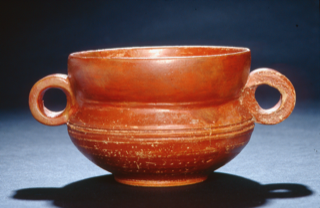Title: Cypriot Sigillata Drinking Cup - 2016.01
Acquisition number: 2016.01
Author or editor: Ruth Mcconnell
Culture or period: Hellenistic
Date: c. 1st century BC
Material: Clay - Terracotta
Object type: Vessels - Cup/mug
Dimensions: 95mm (w) × 68mm (h)
Origin region or location: Syria
Origin city: Jebel Khalid
Display case or on loan: 4
Keywords: Hellenistic, Jebel Khalid, Pottery
G. Clarke, “Preface”, in: H. Jackson and J. Tidmarsh, Jebel Khalid on the Euphrates, vol. 3 - The Pottery (Sydney, 2011) xxx-xxxi.
H. Jackson, Jebel Khalid on the Euphrates, vol. 4 - The Housing Insula (Sydney, 2014).
J. Lund, “A Fresh Look at the Roman and Late Roman Fine Wares from the Danish Excavations at Hama, Syria”, in: H. Meyza and J. Mlynarczyk (eds), Hellenistic and Roman Pottery in the Eastern Mediterranean - Advances in Scientific Studies (Warsaw, 1995) 135-161.
J. Lund, “The Ontogenesis of Cypriot Sigillata”, Acta Hyperborea 9, 2002, 185-223.
J. Tidmarsh, “The Imported Fine Wares at Jebel Khalid”, in: H. Jackson and J. Tidmarsh, Jebel Khalid on the Euphrates, vol. 3 - The Pottery (Sydney, 2011) 279-430.
2016.01
Cypriot Sigillata Drinking Cup
From the excavations at Jebel Khalid, north Syria, inventory number 91.031
On loan from Emeritus Professor Graeme Clarke
Diameter 9.5 cm; height 6.8 cm
Restored from several fragments to form a complete vessel. Fine ware two-handled cup with lustrous red glaze. Two horizontal grooves around the body beneath grooved vertical side handles. Irregular horizontal rouletting above low ring base.
This fine ware cup was unearthed at excavations in Jebel Khalid in north Syria (J. Tidmarsh, “The Imported Fine Wares at Jebel Khalid”, in: H. Jackson and J. Tidmarsh, Jebel Khalid on the Euphrates, vol. 3 (Sydney, 2011) 358, inv. no. 91.031, col. pl. III, pl. 28, fig. 125). It was almost certainly imported from Cyprus, although the exact location for the production of this distinctive glazed ware has yet to be determined. Cypriot Sigillata first appeared around the last years of the 2nd century BC. Its popularity reached its height in the 1st century AD, after which production greatly diminished (J. Tidmarsh, “The Imported Fine Wares at Jebel Khalid”, 357).
Although many fine ware discoveries at the Jebel Khalid site were made at the Acropolis Palace and the Housing Insula, the present cup was unearthed in a commercial area. Cypriot Sigillata wares were rarely found at Jebel Khalid, which mirrors a similar uncommoness in Syria generally, perhaps because abundant fine wares were available from closer manufacturers (J. Tidmarsh, “The Imported Fine Wares at Jebel Khalid”, 279 and 357).
The vast majority of pottery found at Jebel Khalid was locally made common ware. Imported fine wares were luxury goods for use on special occasions (H. Jackson, Jebel Khalid on the Euphrates,vol. 4 (Sydney, 2014) 580). The investigation of imported fine wares at Jebel Khalid provides important information regarding trade links, as well as the preferences and affluence levels of the Hellenistic inhabitants (G. Clarke, “Preface”, in: H. Jackson and J. Tidmarsh, Jebel Khalid on the Euphrates, vol. 3 (Sydney, 2011) xxx).
The shape and patterning of the present cup follows a typical form for Cypriot Sigillata two-handled cups (see J. Lund, “The Ontogenesis of Cypriot Sigillata”, Acta Hyperborea 9, 2002, 193, fig. 4.3). For a good exposition regarding fine ware distribution in Syria, including Cypriot Sigillata, see J. Lund, “A Fresh Look at the Roman and Late Roman Fine Wares from the Danish Excavations at Hama, Syria”, in: H. Meyza and J. Mlynarczyk (eds), Hellenistic and Roman Pottery in the Eastern Mediterranean (Warsaw, 1995) 135-161.
On loan from Emeritus Professor Graeme Clarke
